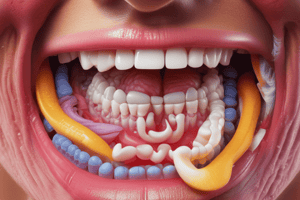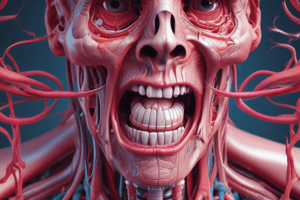Podcast
Questions and Answers
What are the parts of the oral cavity?
What are the parts of the oral cavity?
Vestibule and Mouth cavity proper
What are the boundaries of the vestibule of the mouth?
What are the boundaries of the vestibule of the mouth?
Externally by lips and cheeks, internally by teeth and gums
What structure communicates with the mouth cavity proper?
What structure communicates with the mouth cavity proper?
Oropharynx
What supplies the upper lip with nerve and arterial supply?
What supplies the upper lip with nerve and arterial supply?
Which muscles form the intrinsic muscles of the tongue?
Which muscles form the intrinsic muscles of the tongue?
Match the extrinsic muscles of the tongue with their actions:
Match the extrinsic muscles of the tongue with their actions:
The pharyngeal part of the tongue has taste buds.
The pharyngeal part of the tongue has taste buds.
What is the origin of the genioglossus muscle?
What is the origin of the genioglossus muscle?
The lower surface of the tongue features the _____________ which connects to the floor of the mouth.
The lower surface of the tongue features the _____________ which connects to the floor of the mouth.
What types of papillae are found on the oral part of the tongue?
What types of papillae are found on the oral part of the tongue?
Flashcards are hidden until you start studying
Study Notes
Oral Cavity Anatomy
- Oral cavity consists of two main parts: vestibule and mouth cavity proper.
- Vestibule is located outside the teeth and gums, bounded by lips and cheeks.
- Vestibule receives parotid duct openings opposite the second upper molar tooth.
Mouth Cavity Proper
- Anterior and lateral boundaries formed by alveolar arches of upper and lower jaws.
- Communicates posteriorly with the oropharynx via the oropharyngeal isthmus.
- Roof composed of hard palate (anterior) and soft palate (posterior).
- Floor consists of the tongue and sublingual structures overlying submandibular and mylohyoid muscles.
Lips
- Formed by fleshy fibers of the orbicularis oris muscle.
- External surface covered by skin, internal surface lined with mucous membrane.
- Nerve supply: Upper lip (Buccal branch of facial nerve), Lower lip (Marginal mandibular branch of facial nerve).
- Arterial supply: Upper lip (Superior labial artery), Lower lip (Inferior labial artery).
Cheeks
- Form the sides of the vestibule, limited anteriorly by the nasolabial groove.
- Consist of skin, buccal fat pad, buccopharyngeal fascia, buccinator muscle, and mucous membrane.
- Nerve supply: Skin and mucosa (Buccal branch of mandibular nerve), Buccinator muscle (Buccal branch of facial nerve).
Tongue
- Composed of skeletal muscles covered by mucous membrane; located in the floor of the oral cavity.
- Suspended from structures including the soft palate (palatoglossus muscle), styloid process (styloglossus muscle), mandible (genioglossus muscle), and hyoid bone (hyoglossus muscle).
Surface Structure of Tongue
- Apex and margins positioned behind teeth and gums.
- Root contains extrinsic muscles, connecting tongue to mandible, hyoid, and styloid process.
- Superior surface (dorsum) features a V-shaped sulcus (sulcus terminalis) separating anterior and posterior parts.
- Foramen cecum at the apex of the sulcus.
Inferior Surface of Tongue
- Shows lingual frenulum (connects tongue to mouth floor), deep lingual vein, and plica fimbriata.
- Contains triad of folds: median fold, lateral folds, and vascular structures (V A N).
Oral Part vs. Pharyngeal Part of Tongue
- Oral part (anterior 2/3) has all papilla types: filiform, fungiform, and vallate; innervated by the lingual nerve (general sensation) and chorda tympani (taste).
- Pharyngeal part (posterior 1/3) lacks papillae, contains lymphoid tissue (lingual tonsils), and is innervated by the glossopharyngeal nerve (all sensations).
Intrinsic Muscles of the Tongue
- Include superior longitudinal, inferior longitudinal, transverse, and vertical muscles.
- Function to alter tongue shape for speech, mastication, and swallowing.
Extrinsic Muscles of the Tongue
- Genioglossus muscle: Depresses and draws tongue forward, innervated by hypoglossal nerve.
- Hyoglossus muscle: Depresses the tongue, innervated by hypoglossal nerve.
- Styloglossus muscle: Draws tongue upward and backward, innervated by hypoglossal nerve.
- Palatoglossus muscle: Draws root of tongue upward and closes the oropharynx, innervated by cranial root of accessory nerve.
Studying That Suits You
Use AI to generate personalized quizzes and flashcards to suit your learning preferences.




